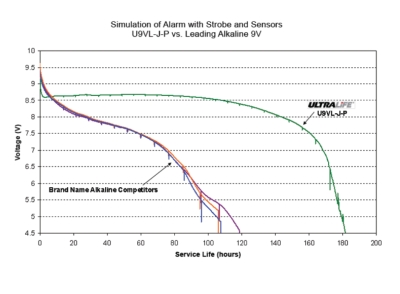Michele Windsor, Ultralife Corp.
Today’s 9-V battery was originally invented for transistor radios in the 1950s. It was eventually standardized into the 1604 international ANSI standard. Of course, these batteries now find use in everything from speakers and smoke alarms to walkie-talkies and industrial meters. But some 9-V batteries aren’t built to handle the wide and diverse applications in which they are found.
The choice of battery for handheld devices depends on three things: size, weight and energy density. Size and weight go without saying. What most people forget, however, is that as battery size shrinks so does runtime. To compensate, choose a battery with a higher energy density so that it will offer the same runtime as a bigger battery.
According to the U.S. National Fire Protection Association (NFPA), dead batteries caused 24% of all smoke alarm failures in 2015. Similarly, safety devices such as security sensors, emergency beacons and telematics and metering devices usually lie dormant for long periods of time, often in extreme environments, only calling on their batteries infrequently.
Safety and security applications are often best served by a battery with a long storage life and a wide temperature range. For example, Ultralife’s U9VLJP lithium-manganese dioxide 9-V battery has been shown to offer a shelf life in excess of ten years with little loss in performance. The battery can also be used in temperatures from -40 to +60°C.

Probably the biggest challenge for the 9-V battery is in medical applications. Devices in medical and healthcare environments usually see more frequent use and the equipment is usually more sensitive to electromagnetic interference.
When choosing a 9-V battery for medical use, consider a high pulse capability and a non-magnetic design. A high pulse rate will deliver consistent power to even the most demanding devices. For example, the Ultralife 9-V battery is designed with low internal impedance so it can supply a high power output with a stable voltage. The U9VLJP also has a low magnetic signature because it is constructed with a stainless steel outer container.
Launched in 1991, the original Ultralife 9-V battery has sold over 100m units worldwide. The U9VLJP weighs just 37 g, conforms to the dimensions of ANSI 1604 and uses Ultralife ThinCell technology, where three individual thin foil cased cells combine to create a 9-V battery having a capacity of 1,200 mAh. That is five times the energy of leading alkaline 9-V batteries.
The U9VLJP is constructed with a shutdown separator internal to each of the three cells. If the internal temperature of the cell is excessive, the normally porous separator closes the pores, permanently disabling the battery. With the increased ability to supply higher pulse and continuous current, a Polymer Positive Temperature Coefficient (PPTC) was added for more safety. This resettable fuse type device limits pulse current to 1.5-A maximum or a 0.7-A continuous hold current.


Leave a Reply